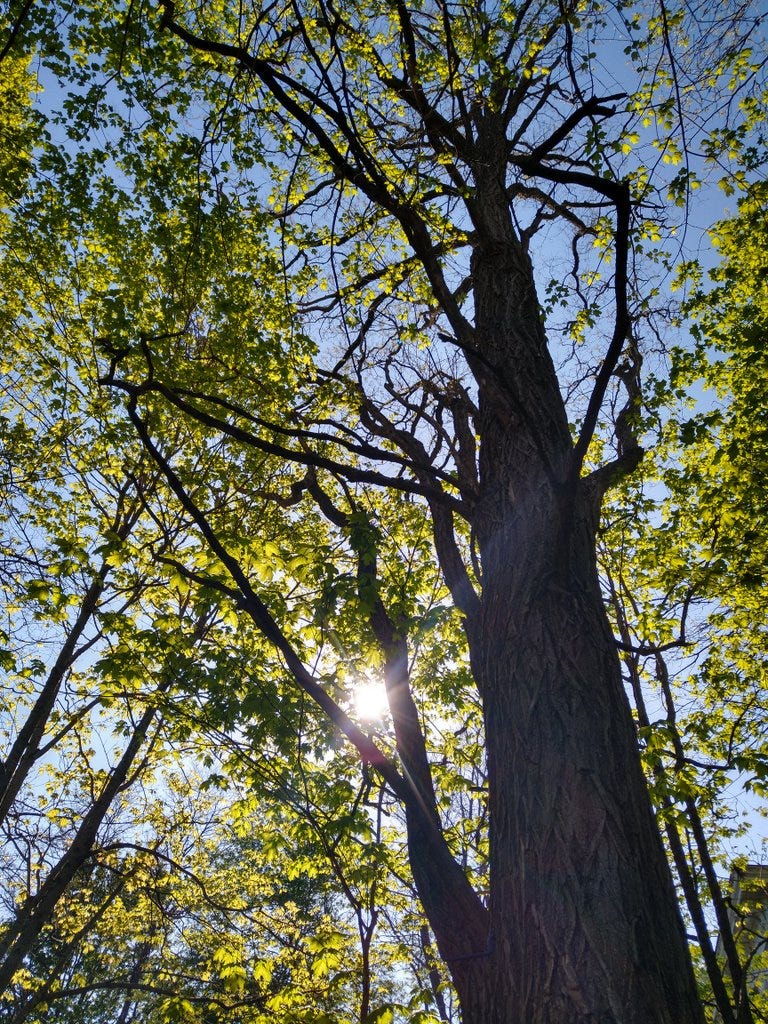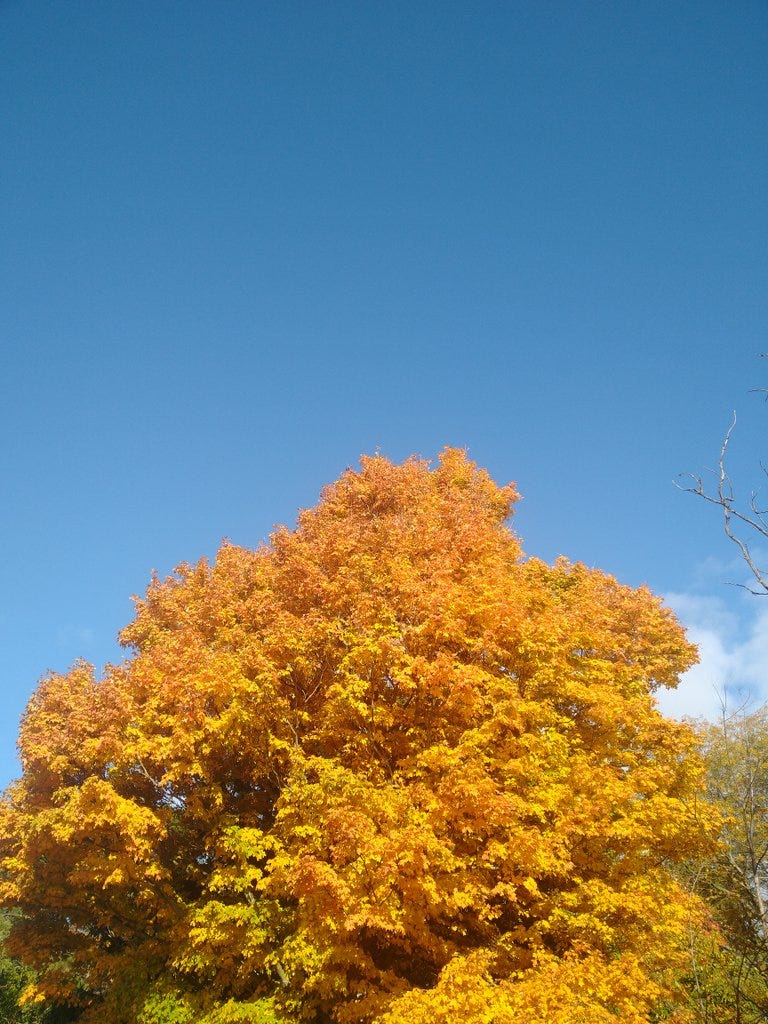Our eight acre farm has about three acres of woods. Most of it is a plantation of black walnut trees that are over 100 years old. A few springs ago, a gentleman came by and said his grandparents built our house, and they planted those trees as a retirement investment. Black walnut wood is quite valuable, but the trees grow very slowly. I don’t know if they ever saw a return on their investment.
The first year we were in the house, someone knocked on our door and offered to buy the trees from us. We declined, as we place a high value on the little forest the walnut stand creates. Bill and I are both from rural NY, and we feel more at home in cool, dark northern hardwood forests, than we do in exposed, flat grasslands. There aren’t a lot of homes in this area that are surrounded by trees, and I think that the woodlot was the primary reason we bought this house.
In the last 15 years we’ve let nature take over a lot of space here, and there are more trees now than when we moved in. We’re not really “managing” the land. This is an interesting topic for thoughtful discourse. Should we try to shape the ecology here? Should we make changes that are beneficial to certain plants or wildlife? What stage of forest development should we promote (or not)? If we take resources from the land, what effect will it have on the other creatures that live on our farm: the fireflies, earthworms, and ticks?
The things that I don’t know about managing, using, and caring for land, far outweigh the things I do know about...well, likely everything. I can make a spreadsheet to help manage a yarn business, but I don’t know squat about using fire to shape a landscape.
So, the things we do on our land are fairly simple and small in scope. We recently tapped some trees and made maple syrup. In NY, we’d do this every year, and we learned how to read the climate and weather to know when to tap the Sugar Maple trees, and when to boil the sap into syrup. As the weather warms in the spring, trees will relocate sugars from their roots to the ends of their branches in order to make new leaves. This happens when the temperatures are freezing overnight, but slightly above freezing during the day. The warm sun on the tree creates a pressure gradient that allows sap to flow up.
When the sap is flowing, we drill a small hole in the south side of the tree (where the sun hits it), insert a metal tap in the hole, and hang a bucket from the tap. This allows some sap to seep out of the hole and into the bucket. On really warm days, the sap flows out rapidly. On colder days, it’s a slower drip. The sap is clear, but a little sticky and has just a hint of sweetness.
Each morning, we would empty our buckets into a big container which we kept in our cold room (basically a homemade walk-in cooler). After about a week, we started boiling the sap down into syrup. As you know, maple syrup is quite thick and can be dark. It is a very, very concentrated form of the sap. It takes 40 gallons of maple sap to make one gallon of maple syrup. It requires a LOT of boiling to evaporate enough water to turn the light free-flowing sap into the thick, dark, viscous syrup.
We did much of the boiling on our wood stove. We have a big flat pan there to add moisture to the air all winter long, so we just replaced it with a pan for syrup and let it boil down for a couple of days – adding sap as we could, and watching the liquid get darker. When the sap is nearly syrup, we moved it to a pot on our actual stove, so that we could control the situation a little more directly. After about a week’s worth of effort collecting sap and boiling it down, we ended up with three half-pints of syrup! It is definitely a treat for special occasions.
Our next adventure in using the forest will be in growing mushrooms! We recently ordered some shiitake plugs – which are apparently little nubs of wood, inoculated with shiitake mycelium. To grow the mushrooms, you cut down a small tree, and drill holes in the log that was the trunk. Then, you hammer the shiitake plugs into the holes, and seal them with beeswax. The log is left in a shady spot, and mushrooms will start growing. It takes a little less than a year to be able to harvest them, and you get about one year of mushroom growth for each inch of diameter of the log you use. Generally, logs of 5 or 6 inches are used because they are easy to work with.
I had hoped to have pictures of this process to show you, but our mail order mushroom plugs are taking quite a tour of the entire country before arriving at the farm. Perhaps next month!
The baby goats are growing! Nearly all the Thanksgiving Week babies are on new farms, but The Face and Guapo are still here teaching Ginger’s quadruplets (born March 3) how to bounce and run, and surf on the sheep. There is a big size difference among these four little ones. Snow Cone and Mocha Butt are the boys and they already feel like boulders when we pick them up. Tulip is holding her own, but tiny sister Llama was getting pushed around too much during nursing time and we started worrying about her not getting enough to eat.
I tried feeding her a bottle but she absolutely hated it. We’ve bottle fed lambs and goat kids before, and I’ve never had an animal refuse to drink from the bottle once they tasted the milk. But, Llama refused. And she refused hard. For nearly a week, I’d sit with her three times a day and end up covered in 3 ounces of milk replacer, while half an ounce would make it into Llama’s tummy.
In the middle of this bottle feeding odyssey, we sold Ghosty’s kids, and started milking her in the morning. I wondered if Llama would drink Ghosty’s milk from the bottle...and then decided to try to give her milk directly from the source. It worked! Each morning we now get Ghosty up on the milking stand, and bribe her to stand nicely with a small tub of corn. But, instead of collecting her milk for us, we let Llama have her fill. She is much faster at nursing than Bill is at milking, and after just a minute or two, her belly is full and she bounces out of the barn to nibble on hay with her siblings. She’s still the smallest goat, but I’m more confident that she’ll continue to grow and thrive now.
It’s raining a lot on the farm recently, and after every rain the world looks greener. We hope you are well!










It’s starting to green up in SE Michigan. The daffodils, pussywillows and chrysanthemums are in bloom. No tulips yet. Thank you for sharing.